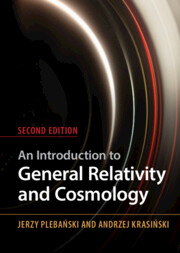Book contents
- Frontmatter
- Contents
- The scope of this text
- Preface to the second edition
- Acknowledgments
- 1 How the theory of relativity came into being (a brief historical sketch)
- Part I Elements of differential geometry
- Part II The theory of gravitation
- 12 The Einstein equations and the sources of a gravitational field
- 13 The Maxwell and Einstein–Maxwell equations and the Kaluza–Klein theory
- 14 Spherically symmetric gravitational fields of isolated objects
- 15 Relativistic hydrodynamics and thermodynamics
- 16 Relativistic cosmology I: general geometry
- 17 Relativistic cosmology II: the Robertson–Walker geometry
- 18 Relativistic cosmology III: the LemaÎtre–Tolman geometry
- 19 Relativistic cosmology IV: simple generalisations of L–T and related geometries
- 20 Relativistic cosmology V: the Szekeres geometries
- 21 The Kerr metric
- 22 Relativity enters technology: the Global Positioning System
- 23 Subjects omitted from this book
- 24 Comments to selected exercises and calculations
- References
- Index
19 - Relativistic cosmology IV: simple generalisations of L–T and related geometries
from Part II - The theory of gravitation
Published online by Cambridge University Press: 30 May 2024
- Frontmatter
- Contents
- The scope of this text
- Preface to the second edition
- Acknowledgments
- 1 How the theory of relativity came into being (a brief historical sketch)
- Part I Elements of differential geometry
- Part II The theory of gravitation
- 12 The Einstein equations and the sources of a gravitational field
- 13 The Maxwell and Einstein–Maxwell equations and the Kaluza–Klein theory
- 14 Spherically symmetric gravitational fields of isolated objects
- 15 Relativistic hydrodynamics and thermodynamics
- 16 Relativistic cosmology I: general geometry
- 17 Relativistic cosmology II: the Robertson–Walker geometry
- 18 Relativistic cosmology III: the LemaÎtre–Tolman geometry
- 19 Relativistic cosmology IV: simple generalisations of L–T and related geometries
- 20 Relativistic cosmology V: the Szekeres geometries
- 21 The Kerr metric
- 22 Relativity enters technology: the Global Positioning System
- 23 Subjects omitted from this book
- 24 Comments to selected exercises and calculations
- References
- Index
Summary
The plane- and hyperbolically symmetric counterparts of the L–T models (i.e. the Ellis solutions), and generalisations of all three classes to charged dust source are derived and discussed. It is shown that the most natural interpretation of the plane-symmetric Ellis metric is an expanding or contracting family of 2-dimensional flat tori. The proof of the Ori theorem that for a spherically symmetric weakly charged dust ball shell crossings will block the bounce through the minimal radius is copied in detail. A subcase left out by Ori is discussed, but it will also lead to a shell crossing, only at the other side of the minimal radius. In this special case, a peculiar direction-dependent singularity is present: at the centre the matter density becomes negative for a short period before and after the bounce. The Datt–Ruban solution, its generalisation to charged dust source and the matching of both these solutions to, respectively, the Schwarzschild and Reissner–Nordstr\“{o}m solutions are presented and discussed. In the matched configuration the DR region stays inside the Schwarzschild or RN event horizon.
- Type
- Chapter
- Information
- An Introduction to General Relativity and Cosmology , pp. 366 - 390Publisher: Cambridge University PressPrint publication year: 2024

